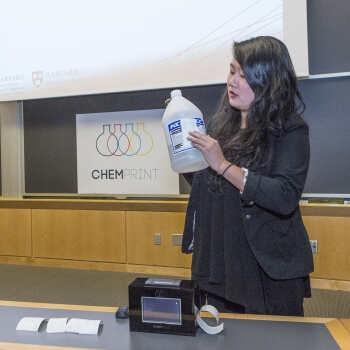News
Shuya Gong, S.B. ’17, a mechanical engineering concentrator, demonstrates the ChemPrint system. (Photo by Eliza Grinnell/SEAS Communications.)
Hazardous materials accidents claimed the lives of about 1,100 people in the U.S., injured nearly 2,000, and resulted in more than $200 million in environmental remediation costs in 2012, according data compiled by legal resource website LegalMatch.
At Harvard University, where cutting-edge research sometimes involves the use of hazardous chemicals, the safety of students, faculty, and staff rests with the Office of Environmental Health and Safety (EH&S). While Harvard has a commendable safety record, this 62-person office (which has 27 employees assigned to the laboratory safety sub-unit) faces the daunting challenge of monitoring the enormous amount of chemicals that are stored, utilized, and disposed of in more than 600 laboratories.
A team of John A. Paulson School of Engineering and Applied Sciences (SEAS) students produced a tech-driven solution that could help EH&S more efficiently catalogue Harvard’s hazardous chemicals. For their collaborative project in Engineering Problem Solving and Design (ES 96), the students developed a wireless label printing system that streamlines and standardizes the process of tagging hazardous materials and wastes.
Students (from left) Shuya Gong, Jacob Scherba, Jake Horton, Ryan Davey, Patrick Hansen, and Taciana Pereira created an efficient chemical label printing system that uses an iPhone app and a wireless thermal printer. (Photo by Eliza Grinnell/SEAS Communications.)
Their project, called ChemPrint, connects a wireless printer to a voice recognition iPhone app that enables lab staff to customize chemical bottle labels. An individual speaks the name of each chemical component and its volume in milliliters into the app to generate a label that clearly lists each material and its percentage in the solution. The user then identifies relevant hazards by selecting from a menu of terms such as “acid” or “corrosive.” Completed labels can be stored in a phone’s memory or sent to the wireless thermal printer.
“ChemPrint will give lab safety officers more time to do their own research because they will spend less time trying to decipher tags on chemical bottles that have been filled out incorrectly,” said Jacob Scherba, S.B. ’18, a bioengineering concentrator pursuing a secondary in computer science. “It will also give EH&S a more consistent stream of data they can use to track the chemical waste that is leaving Harvard.”
Generating more reliable data could be a boon for EH&S, which tracks chemicals using a “cradle to grave” approach. Harvard is responsible for how hazardous materials are handled on campus as well as how chemical waste is disposed of.
After considering seven different solutions, including a $66,500 mobile spectroscopy system, the students decided on a label printer that is cost-effective and easier for diverse lab groups to implement, Scherba said. A ChemPrint system costs about $160.
The thermal printer the students utilized for their ChemPrint system is designed to be portable and easily mounted onto a fume hood or other area of a laboratory. (Photo by Eliza Grinnell/SEAS Communications.)
The biggest challenges the students faced as they refined the finished product was seamlessly connecting so many different interfaces, including the thermal printer, Raspberry Pi miniature computer, and app, said Shuya Gong, S.B. ’17, a mechanical engineering concentrator.
“We were surprised by the depth of the system that EH&S has to manage and the levels of complexity involved in the different waste streams coming from Harvard’s 600-plus laboratories,” Gong said. “I think we’ve come up with a solution that is accessible for the individual researcher or lab and fits well into the overall university infrastructure. That enables change to happen slowly, bit by bit.”
The beauty of ChemPrint lies in its simplicity, which opens the door for enhancements, Scherba said. Future work might include an Android platform, QR code integration to make it easier for EH&S to scan hazardous waste tags, and seamless connection to an online inventory system.
The potential for integration with existing tracking and management systems makes ChemPrint an especially viable solution to a continual problem, said Bill VanSchalkwyk, managing director of EH&S.
“I’m impressed by the students’ solution because it is simple and takes a lot of guesswork out of the process,” said VanSchalkwyk. “It is very difficult to innovate relative to hazardous materials because they are controlled by some of the most prescriptive government regulations that we find in environmental health and safety.”
Instructor David Mooney, Robert P. Pinkas Family Professor of Bioengineering, was pleased by how well the students worked together to understand those thorny regulations and the complicated nature of EH&S operations.
“I think the students did a wonderful job distilling a complex problem down to the key challenges. They were able to approach those challenges with some real creativity to develop a very feasible solution,” said Mooney. “My hope is that this experience has also given them a good understanding of how the design process works.”
Topics: Academics
Cutting-edge science delivered direct to your inbox.
Join the Harvard SEAS mailing list.
Press Contact
Adam Zewe | 617-496-5878 | azewe@seas.harvard.edu



